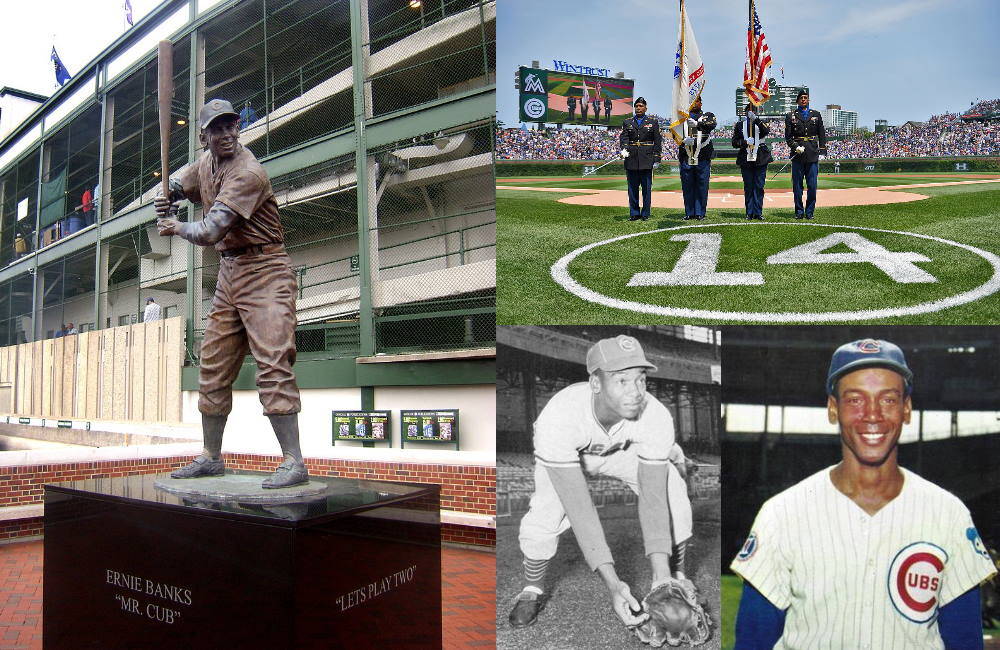People in the Windy City still speak with reverence about Ernie Banks, who played his entire career with the Chicago Cubs. Banks ranks among the best players of his generation, but also epitomized the sense of fun and joy so many feel about the game.
Banks once famously said, on a beautiful spring day in Chicago, “There’s sunshine, fresh air, and the team’s behind us. Let’s play two.” His attitude and love of the game earned him the nickname “Mr. Cub.”
Banks became a member of the Baseball Hall of Fame in 1977. He was named to the All-Century Team in 1999. Banks began his career in the Negro Leagues, transitioning to the Major Leagues in the early 1950s. He is considered by many as one of the greatest players of all time.
Ernie Banks’ Early Life
Ernie Banks was born on Jan. 31, 1931 in Dallas, one of 12 children. His father, Eddie Banks, played baseball with the Dallas Black Giants. It was Banks father who gave him his first glove, at the age of eight.
Banks played football and basketball at Booker T. Washington High School in Dallas, but the school did not offer baseball. Instead, Banks played in a local church softball league. Under his father’s teaching, though, he became a good hitter at a young age.
Bill Blair, a graduate of Booker T. Washington High School, saw Banks play and talked his parents into letting Banks play for a traveling team out of Amarillo, Texas, that was a feeder team to the Negro Leagues. Although just a sophomore in high school, Banks won the starting shortstop job and hit a home run in his third game.
5 Greatest Negro League Players
Kansas City Monarchs and Korean War
Banks returned to Dallas for his junior year in high school, having traveled around Texas, New Mexico, Oklahoma and Nebraska as a member of the Amarillo club. After his junior year, he went back to the Amarillo team. One person who saw him play was Cool Papa Bell, who recommended Banks to Kansas City Monarchs manager Buck O’Neil. In 1950, Banks joined the Monarchs, one of the most successful of the Negro League teams.
Banks hit well in his rookie year. Jackie Robinson also invited him to tour with the “Jackie Robinson All-Stars,” a team that included Roy Campanella, Don Newcombe and Larry Doby.
In 1951, the U.S. Army drafted Banks during the Korean War. He spent the war at Fort Bliss in El Paso, Texas, and in Germany. Discharged in January 1953, Banks returned to the Monarchs. But by then, more black players were going to the majors. The Chicago Cubs ended up paying the Monarchs $20,000 for the rights to Banks.
Ernie Banks’ MLB Career
Banks did not spend a day in the minors, having already been seasoned in Amarillo and Kansas City. He hit .314 in the last 10 games of 1953. In his first full season in 1954, Banks hit .275 with 19 home runs and 79 RBI, the first of 17 straight seasons with double digit home run totals.
With second baseman Gene Baker, Banks played as part of the first all-black double play combination in Major League history.
Banks’ 1955 season started a streak of monster offensive years. He hit 44 home runs that year and drove in 117 RBI. He also scored 98 runs. Banks made his first All-Star team that season, the first of 11.
Thanks to the Cubs never putting together a winning team, Banks never played in the postseason. But the milestones from his career are many.
- He became the first National League player named MVP in back-to-back seasons (1958-1959)
- He played both shortstop and, from 1961 on, first base for the Cubs. He led the league in fielding percentage three times and won a Gold Glove in 1960
- He hit more than 40 home runs in five seasons
- He became just the ninth player to hit 500 home runs in his career (he retired with 512)
That 500th home run came on May 12, 1970, one of 12 that Banks hit that season in a backup role. After one last year with the Cubs in 1971, Banks retired at the age of 40.
After baseball, Banks did well. During his career, he invested his money wisely. He also opened the first black-owned Ford dealership in America on Chicago’s south side. He established the Live Above & Beyond Foundation that assisted both kids and the elderly with healthcare issues. He also became an ordained minister.
Banks died on Jan. 23, 2015 of a heart attack and is buried in Graceland Cemetery, less than a half mile up Clark Street from Wrigley Field.


The 1969 Cubs finished in 2th place in the NL East with a record of 92-70.